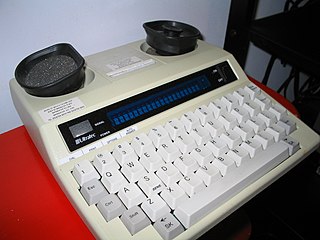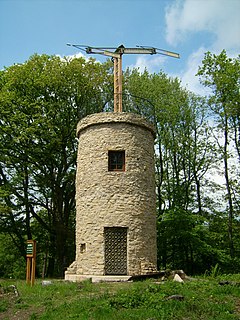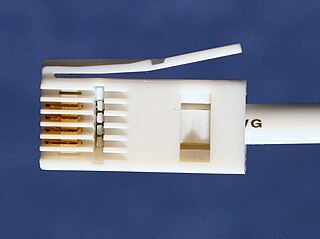
A teleprinter is an electromechanical device that can be used to send and receive typed messages through various communications channels, in both point-to-point and point-to-multipoint configurations. Initially they were used in telegraphy, which developed in the late 1830s and 1840s as the first use of electrical engineering, though teleprinters were not used for telegraphy until 1887 at the earliest. The machines were adapted to provide a user interface to early mainframe computers and minicomputers, sending typed data to the computer and printing the response. Some models could also be used to create punched tape for data storage and to read back such tape for local printing or transmission.
In telecommunications, a customer-premises equipment or customer-provided equipment (CPE) is any terminal and associated equipment located at a subscriber's premises and connected with a carrier's telecommunication circuit at the demarcation point ("demarc"). The demarc is a point established in a building or complex to separate customer equipment from the equipment located in either the distribution infrastructure or central office of the communications service provider.
Telephony is the field of technology involving the development, application, and deployment of telecommunication services for the purpose of electronic transmission of voice, fax, or data, between distant parties. The history of telephony is intimately linked to the invention and development of the telephone.
Data transmission and data reception or, more broadly, data communication or digital communications is the transfer and reception of data in the form of a digital bitstream or a digitized analog signal over a point-to-point or point-to-multipoint communication channel. Examples of such channels are copper wires, optical fibers, wireless communication using radio spectrum, storage media and computer buses. The data are represented as an electromagnetic signal, such as an electrical voltage, radiowave, microwave, or infrared signal.

A telecommunications network is a group of nodes interconnected by telecommunications links that are used to exchange messages between the nodes. The links may use a variety of technologies based on the methodologies of circuit switching, message switching, or packet switching, to pass messages and signals.
Voice over Internet Protocol (VoIP), also called IP telephony, is a method and group of technologies for the delivery of voice communications and multimedia sessions over Internet Protocol (IP) networks, such as the Internet. The terms Internet telephony, broadband telephony, and broadband phone service specifically refer to the provisioning of communications services over the Internet, rather than via the public switched telephone network (PSTN), also known as plain old telephone service (POTS).

A telecommunications device for the deaf (TDD) is a teleprinter, an electronic device for text communication over a telephone line, that is designed for use by persons with hearing or speech difficulties. Other names for the device include teletypewriter (TTY), textphone, and minicom.
In telecommunications, in-band signaling is the sending of control information within the same band or channel used for data such as voice or video. This is in contrast to out-of-band signaling which is sent over a different channel, or even over a separate network. In-band signals may often be heard by telephony participants, while out-of-band signals are inaccessible to the user. The term is also used more generally, for example of computer data files that include both literal data, and metadata and/or instructions for how to process the literal data.
In telecommunications networks, a node is either a redistribution point or a communication endpoint. The definition of a node depends on the network and protocol layer referred to. A physical network node is an electronic device that is attached to a network, and is capable of creating, receiving, or transmitting information over a communication channel. A passive distribution point such as a distribution frame or patch panel is consequently not a node.

A business telephone system is a multiline telephone system typically used in business environments, encompassing systems ranging in technology from the key telephone system (KTS) to the private branch exchange (PBX).

The history of telecommunication began with the use of smoke signals and drums in Africa, Asia, and the Americas. In the 1790s, the first fixed semaphore systems emerged in Europe. However, it was not until the 1830s that electrical telecommunication systems started to appear. This article details the history of telecommunication and the individuals who helped make telecommunication systems what they are today. The history of telecommunication is an important part of the larger history of communication.

A modular connector is a type of electrical connector for cords and cables of electronic devices and appliances, such as in computer networking, telecommunication equipment, and audio headsets.

This history of the telephone chronicles the development of the electrical telephone, and includes a brief overview of its predecessors. The first telephone patent was granted to Alexander Graham Bell in 1876.
The following outline is provided as an overview of and topical guide to telecommunication:

Telecommunications Engineering is an engineering discipline centered on electrical and computer engineering which seeks to support and enhance telecommunication systems. The work ranges from basic circuit design to strategic mass developments. A telecommunication engineer is responsible for designing and overseeing the installation of telecommunications equipment and facilities, such as complex electronic switching systems, and other plain old telephone service facilities, optical fiber cabling, IP networks, and microwave transmission systems. Telecommunications engineering also overlaps with broadcast engineering.

British telephone sockets were introduced in their current plug and socket form on 19 November 1981 by British Telecom to allow subscribers to connect their own telephones. The connectors are specified in British Standard BS 6312. Electrical characteristics of the telephone interface are specified by individual network operators, e.g. in British Telecom's SIN 351. Electrical characteristics required of British telephones used to be specified in BS 6305.

Telecommunications equipment is a hardware which is used for the purposes of telecommunications. Since the 1990s the boundary between telecoms equipment and IT hardware has become blurred as a result of the growth of the internet and its increasing role in the transfer of telecoms data.
A call detail record (CDR) is a data record produced by a telephone exchange or other telecommunications equipment that documents the details of a telephone call or other telecommunications transactions that passes through that facility or device. The record contains various attributes of the call, such as time, duration, completion status, source number, and destination number. It is the automated equivalent of the paper toll tickets that were written and timed by operators for long-distance calls in a manual telephone exchange.
Operations support systems (OSS), operational support systems in British usage, or Operation System (OpS) in NTT, are computer systems used by telecommunications service providers to manage their networks. They support management functions such as network inventory, service provisioning, network configuration and fault management.

Telecommunication is the transmission of information by various types of technologies over wire, radio, optical, or other electromagnetic systems. It has its origin in the desire of humans for communication over a distance greater than that feasible with the human voice, but with a similar scale of expediency; thus, slow systems are excluded from the field.











